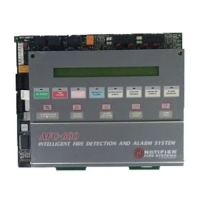$
HQGL[ ( *ORVVDU
AFC-600 Operations PN 51033:A 3/8/99 87
$SSHQGL[(*ORVVDU\
This section contains descriptions of terms essential to know when programming the
control panel.
Alarm History
See History buffer.
Alarm Verification Timer
A user-defined global software timer function (set using
option 7, System) that can reduce the number of nuisance alarms. When you select
Alarm Verification for a detector, the control panel delays an alarm signal for a
user-specified time period. (The control panel ignores the Alarm Verification Timer if it
detects another alarm during the verification period.)
All Systems Normal message
A message that displays, along with the current system
date and time, on the bottom line of the LCD display during normal operation of the
control panel.
Auto Silence Timer
A user-defined global software timer that functions like pressing
the
ALARM
SILENCE
key. For example, select 600. The control panel silences all active
outputs programmed as silenceable. When the timer reaches 600 seconds (10 minutes),
the control panel turns on all active outputs programmed as silenceable.
Control/relay module
An addressable control module that a) switches power to a
Style Y or Style Z NAC or b) functions as a Form-C control relay.
CBE (Control-By-Event)
A programming method that lets you map inputs and
outputs to provide a variety of output responses based on various initiating conditions
(events).
CBE list
Inputs (detectors and monitor modules) and outputs (Control/relay modules,
NACs, and Panel Circuits) provide up to five zone selections for CBE programming.
History buffer
The control panel maintains a History buffer of the last 800 events,
each with a time and date stamp. History events include all alarms, troubles, operator
actions, and programming entries. The control panel also maintains a 200-event
Alarm
History buffer
, which consists of the 200 most recent alarm events from the 800-event
History buffer.
latching
An attribute of a device that deactivates a device so it cannot be returned to
active until the condition causing the deactivation is corrected and the control panel is
reset.
Monitor module
An addressable monitor module that monitors conventional initiating
devices.
NAC (Notification Appliance Circuit)
A circuit or path directly connected to a
notification appliance device (a fire alarm system component—such as a bell, speaker,
strobe, printer, and so on—that produces an audible output, a visual output, or both). On
the AFC-600, an NAC is one of four output circuits (TB7-TB10 on the MPS-6) with
addresses B01-B04.
non-latching
An attribute of a device that follows the state of the fire alarm system.
That is, if a device is non-latching, it returns to its normal state automatically when the
condition clears.
obscuration
A reduction in the atmospheric transparency caused by smoke, usually
expressed in percent per foot.
output circuit
A control module connected to the SLC, a device connected to one of
the four NACs, or a Panel Circuit, such as an ICM-4, connected to J1 or J2 on the
control panel.
Technical Manuals Online! - http://www.tech-man.com

